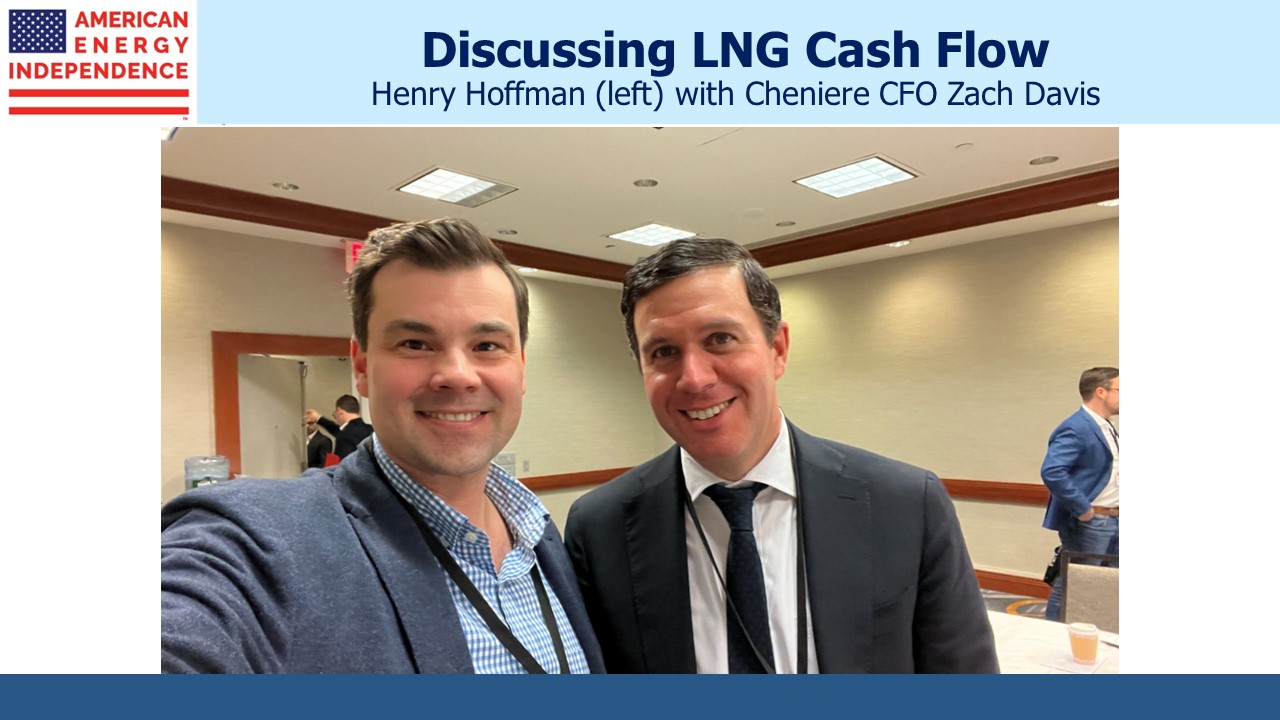Report From The Wells Fargo Conference
SL Advisors partner Henry Hoffman spent a couple of days last week at the Wells Fargo Midstream and Utilities Symposium.

He had the opportunity to meet with many of our portfolio companies and drew some useful insights.
Below are Henry’s notes from the event.
Chatter at the Conference:
Throughout the one-on-one meetings, hallway conversations, and mealtime discussions, Equitrans (ETRN) was a hot topic. Everyone seemed intrigued by the article published last Friday, hinting at a possible sale of the company. Questions arose: had they received a tempting offer, prompting them to explore broader interest? And if so, who might the potential buyer be? Could a deal materialize before the Mountain Valley Pipeline project’s valves were even turned on? One CEO humorously referred to ETRN as “eye candy for anyone who looks at a map.” Speculation was rampant, with my personal favorite theory coming from an analyst at a hedge fund who suggested they might have received an offer from Energy Transfer, sparking the “leak” for Williams to swoop in as a white knight defensive bidder against ET’s potential encroachment into Williams’ territory. The conference buzzed with theories and excitement, and the possibility of a bidding war for ETRN could inject fresh energy into the midstream sector.
Editor’s Note: Wells Fargo thinks Kinder Morgan may also be an interested buyer.
Most Impressive Management of the Conference:
Cheniere’s CFO, Zach Davis, delivered a meticulously calculated approach to value creation at Cheniere (LNG). Their disciplined strategy has allowed them to offer LNG liquefaction rates at a substantial premium compared to competitors, with no trouble filling new capacity slots to the satisfaction of existing customers. Cheniere’s ability to generate surplus free cash flow provides them with significant flexibility for investments in additional trains, debt reduction, or share buybacks, all geared towards enhancing shareholder value.

Topic That Left Me Puzzled:
A surprising revelation at the conference was that Carbon Capture, Utilization, and Storage (CCUS) is progressing more slowly than anticipated. Despite the potential for substantial financial incentives from Congress, there appears to be a lack of urgency from the Biden administration in providing guidance and clarity. Consequently, there have been fewer Class 6 wells drilled than expected. This came as a surprise since one might have assumed that drilling vertical wells and injecting CO2 would be a straightforward geological matter, especially without the pushback from anti-fossil fuel groups, given that CCUS directly involves capturing CO2. The expected surge in CCUS activity after the Inflation Reduction Act has yet to materialize, and the industry seems to be off to a slow start.
#1 Misunderstood Story:
Ironically, the simplest narrative appears to be the most misunderstood investment opportunity in the industry. NextDecade’s (NEXT) CEO, Matt Schatzman, outlined the case for the first three trains (Phase 1) at the Rio Grande site in South Texas as laying the foundation for a massive LNG facility akin to Cheniere’s. Phase 1 brought in strategic partner Total Energies, a lending syndicate of 30 major banks, EPC partner Bechtel, and equity partners, including premier private equity infrastructure fund Global Infrastructure Partners (GIP), GIC (Singaporean sovereign wealth fund), and Mubadula (the sovereign wealth fund of the Emirate of Abu Dhabi). These partnerships enhance the certainty of additional trains, which promise significantly higher economics for NEXT.
Phase 1’s estimated cash inflow of ~$250 million for all three trains translates to roughly $83 million per train. By contrast, Trains 4 and 5 are projected to yield $700-$1 billion in cash flows or approximately $425 million per train, including the option for equity partners to participate. Furthermore, NEXT has the land available for three more trains (Trains 6-8), which are expected to offer even better economics, as they do not have the same obligations to current equity partners as options on Trains 4-5. There’s also the potential upside from their Carbon Solutions business, although this remains uncertain, as touched upon earlier.
Energized CEO Award:
Kinetik Holdings CEO Jamie Welch exuded enthusiasm for the investment case. In his distinctive Australian accent, he referred to 2024 as a “barn burner” year, anticipating a sharp drop in capital expenditure and a surge in free cash flow. He was highly optimistic about creating substantial shareholder value, to be realized when they find the right buyer for the company.
Additional Insight on M&A:
During the conference, Enterprise Products (EPD) Co-CEO & CFO, Randy Fowler, shared astute comments on M&A in the midstream sector. He believes that strategic buyers will dominate the landscape. However, Fowler emphasized the need for strategic buyers to exercise caution when considering private equity acquisitions, citing concerns about quality and downstream commitments. When you buy an asset, you really want the flexibility to control the molecule. For a purchase to be viable for them, it must meet two key criteria: it must possess “industrial merits” and be accretive to cash flow per unit when adjusted for leverage.
More By This Author:
Bond Rally Boosts PipelinesAnother Climate Conference
Natural Gas Liquids – The Forgotten Cousins



